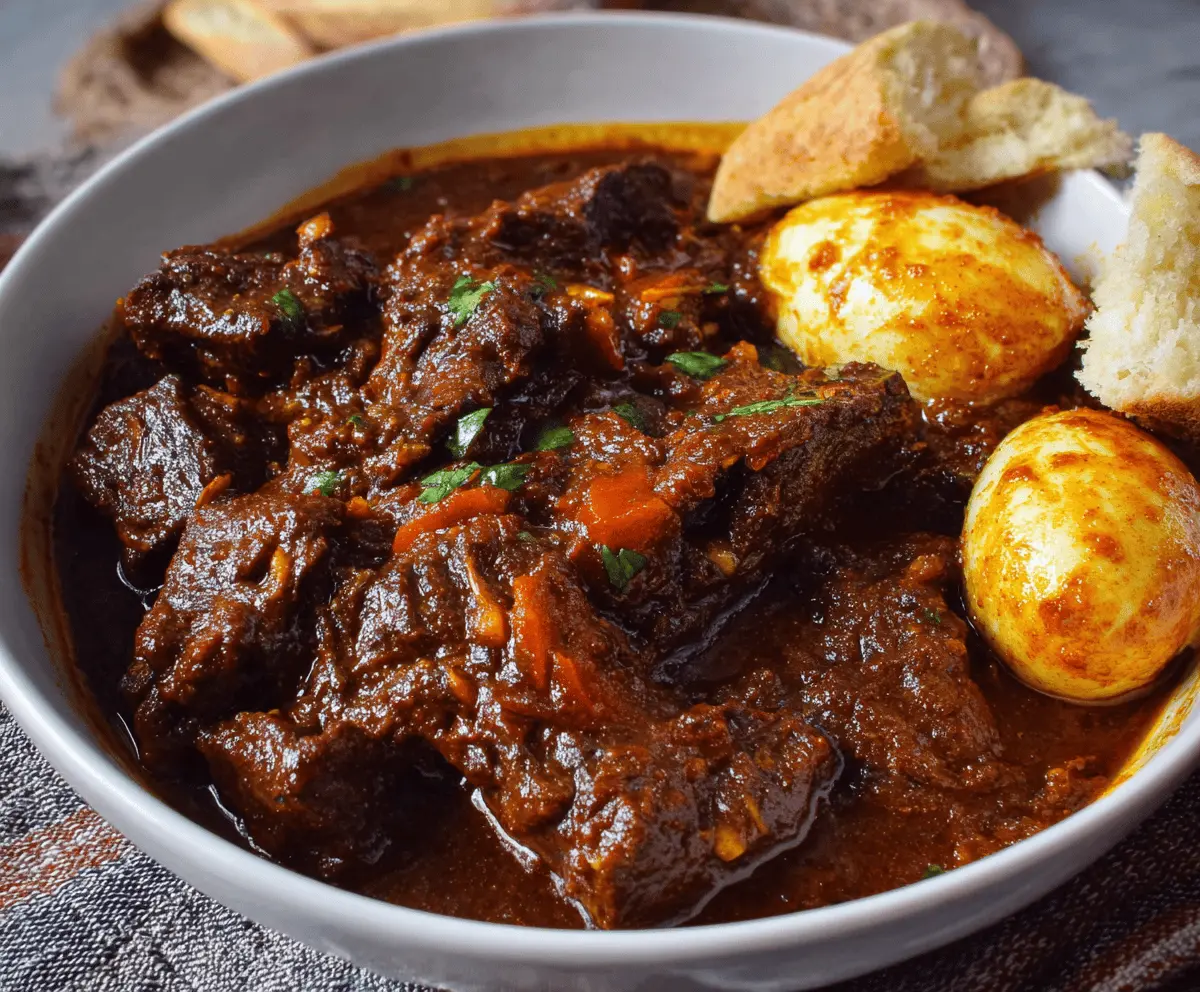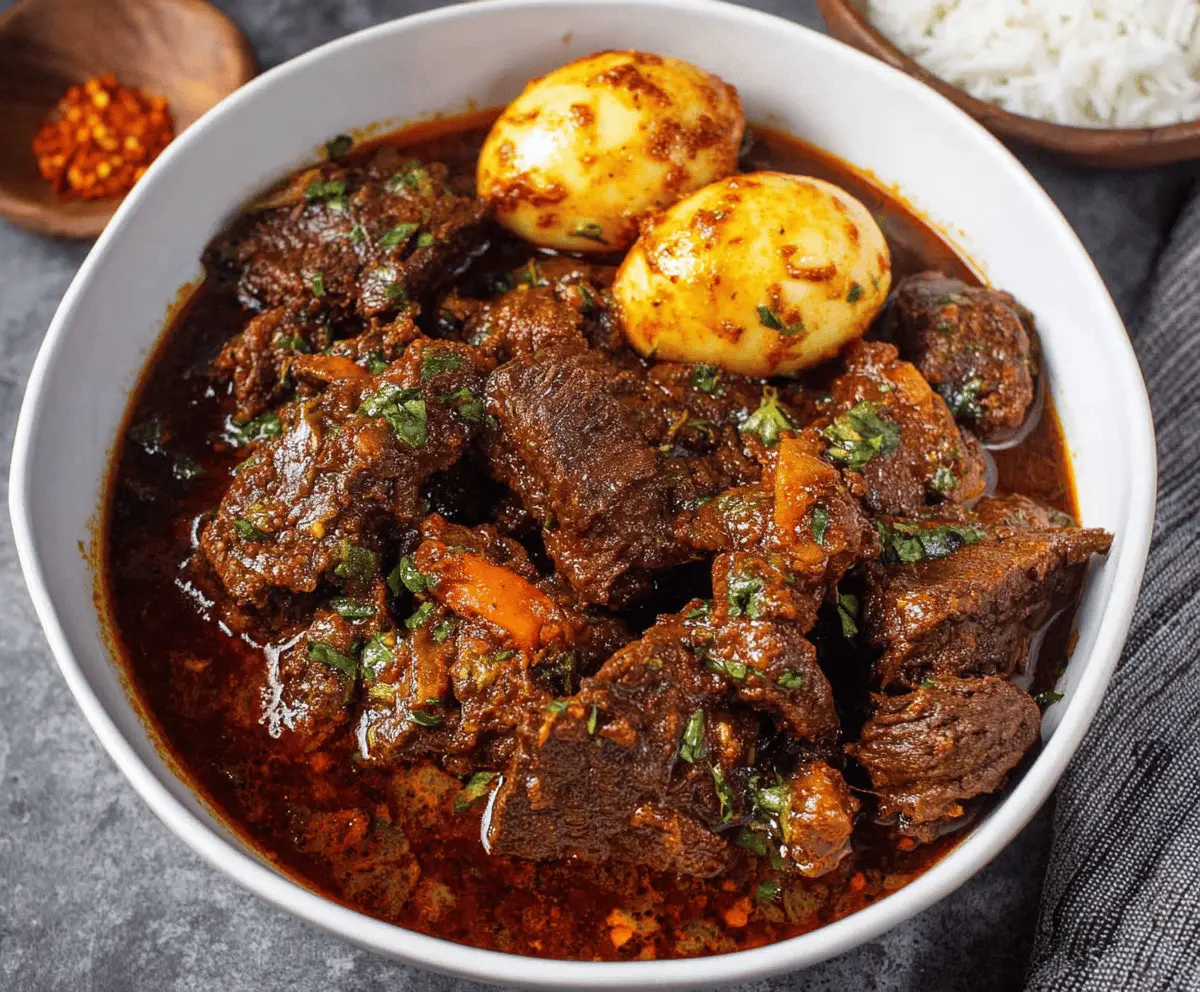This Ethiopian Beef Stew, also known as Doro Wat, is a mouthwatering dish packed with tender beef and a rich mix of spices. It warms you up from the inside out!
Cooking this stew feels like a hug in a bowl! I always serve it with some fluffy injera bread, which is perfect for soaking up that delicious sauce. Yum!
Key Ingredients & Substitutions
Beef Chuck: This cut is perfect for stewing because it becomes tender and flavorful. You could also use brisket or round if you’re looking for alternatives that hold up well during long cooking.
Niter Kibbeh: This special spiced butter adds authentic flavor. If you don’t have it, unsalted butter works just fine. You can even infuse regular butter with spices for a homemade touch.
Berbere Spice Mix: This is a key ingredient that gives the stew its signature flavor. If it’s hard to find, a mix of chili powder, smoked paprika, and some cumin can work in a pinch, though it may change the taste a bit.
Hard-Boiled Eggs: Adding eggs is a traditional touch for extra richness. If you’d rather skip them, the stew is still delicious! Or you can add chickpeas or lentils for a different protein source.
How Do You Achieve Perfectly Caramelized Onions?
Caramelizing onions is crucial for deep flavor in this stew. It takes patience, but the results are worth it! Here’s how to get it right:
- Heat your pot on medium. Melt the niter kibbeh or butter.
- Add diced onions, stirring frequently to prevent burning.
- Cook them slowly for about 20-30 minutes until they are soft and deep golden brown. This enhances the natural sweetness.
- Remember, patience is key! Don’t rush it; the deeper the color, the better the flavor.

How to Make Ethiopian Beef Stew (Siga Wat)
Ingredients You’ll Need:
For the Stew:
- 2 lbs beef chuck, cut into chunks
- 2 large onions, finely chopped
- 3-4 cloves garlic, minced
- 1 tablespoon fresh ginger, minced
- 3 tablespoons niter kibbeh (Ethiopian spiced clarified butter) or unsalted butter
- 3 tablespoons berbere spice mix
- 1 tablespoon paprika
- 1 teaspoon ground cardamom
- 1/2 teaspoon ground cinnamon
- 1/4 teaspoon ground cloves
- 1/4 cup tomato paste
- 2 cups beef broth or water
- Salt to taste
- 3-4 hard-boiled eggs (optional)
- Fresh cilantro or parsley, chopped for garnish
How Much Time Will You Need?
This delicious Ethiopian Beef Stew takes about 30 minutes of active cooking time, plus 1.5 to 2 hours of simmering for the beef to become tender. In total, you’ll need around 2 to 2.5 hours from start to finish, but most of that will be hands-off while it’s simmering!
Step-by-Step Instructions:
1. Prepare the Base:
Heat a large pot over medium heat and add the niter kibbeh (or unsalted butter). Once melted, add the finely chopped onions. Cook slowly for about 20-30 minutes, stirring frequently, until the onions are deeply caramelized and soft. This is key to developing the depth of flavor in your stew!
2. Add Aromatics:
Stir in the minced garlic and ginger into the pot, cooking for about 2 minutes. You want it to be fragrant but not burned—so keep an eye on it!
3. Mix in the Spices:
Add the berbere spice, paprika, cardamom, cinnamon, and cloves to the onion mixture. Stir well to coat the onions and let them cook for about 3-5 minutes. This will release all those lovely aromas!
4. Brown the Beef:
Next, add the beef chunks to the pot. Stir them around to ensure they are well-coated in the spiced onion mixture, then brown the meat for about 5 minutes.
5. Build the Stew:
Now stir in the tomato paste, mixing it into the beef and onions. Then add enough beef broth or water to cover the meat. Bring the mixture to a boil.
6. Let it Simmer:
Reduce the heat to low, cover the pot, and let it simmer gently for 1.5 to 2 hours. The stew is ready when the beef is tender and the sauce has thickened. Make sure to stir occasionally and add extra broth or water if it seems too thick.
7. Add Hard-Boiled Eggs:
If you’re using eggs, about 15 minutes before the stew finishes simmering, add in the hard-boiled eggs. Let them heat through and soak up those yummy flavors!
8. Taste and Adjust:
Give the stew a taste and adjust the salt as needed. This is your chance to make it just right for your preference!
9. Serve and Enjoy:
Garnish your stew with fresh chopped cilantro or parsley. Serve hot, traditionally with injera bread for sopping up the delicious sauce or over a bed of steamed rice.
Enjoy the rich, spicy depth of this Ethiopian Beef Stew—your taste buds will thank you!

Can I Use a Different Cut of Meat?
Absolutely! While beef chuck is ideal for stewing due to its tenderness, you can use other cuts like brisket or round. Just keep in mind that cooking times may vary slightly depending on the cut chosen.
Can I Make This Recipe Vegetarian?
Yes! For a vegetarian version, substitute the beef with hearty vegetables like mushrooms or jackfruit, and replace the beef broth with vegetable broth. You can also add chickpeas or lentils for extra protein.
How Should I Store Leftovers?
Store leftover stew in an airtight container in the refrigerator for up to 3 days. To reheat, simply warm it up on the stove or in the microwave until heated through. The flavors actually improve after a day or two!
What Can I Serve with Ethiopian Beef Stew?
This stew is traditionally served with injera, a sourdough flatbread native to Ethiopia, perfect for scooping up the stew. If you don’t have injera, serve it over rice or with flatbreads for a satisfying meal!


